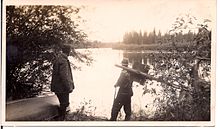Karl Clark (chemist)
Karl Clark (20 October 1888, Georgetown, Ontario – 1966) was a chemist and oil sand researcher. He is best known for perfecting a process that uses hot water to separate oil from oil sands.[1][2][3][4]

Clark earned Bachelor and master's degree from McMaster University before obtaining a Doctorate in Chemistry from the University of Illinois. He then became a Professor at the University of Alberta. In 1925, while working for the Alberta Research Council, he discovered the hot water oil separation process, which he patented in 1929. Today essentially the same method is used for obtaining crude oil from Alberta's oilsands in Fort McMurray.
References
- ^ "Dr. Karl A. Clark". canadianpetroleumhalloffame.ca. Retrieved 28 February 2014.
- ^ "Karl A. Clark - University of Alberta Archives". archives.library.ualberta.ca. Retrieved 28 February 2014.
- ^ "Karl Adolf Clark". thecanadianencyclopedia.com. Retrieved 28 February 2014.
- ^ Barnes, Dan. "Profile: Karl Clark, the scientist". edmontonjournal.com. Retrieved 28 February 2014.
External links
- Biography at Alberta's Petroleum Heritage Edukit.
